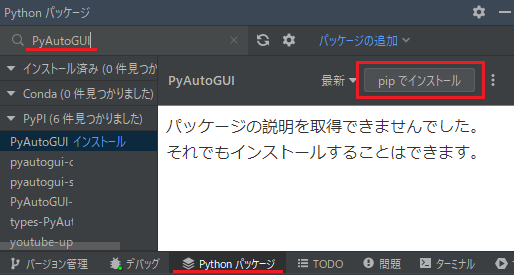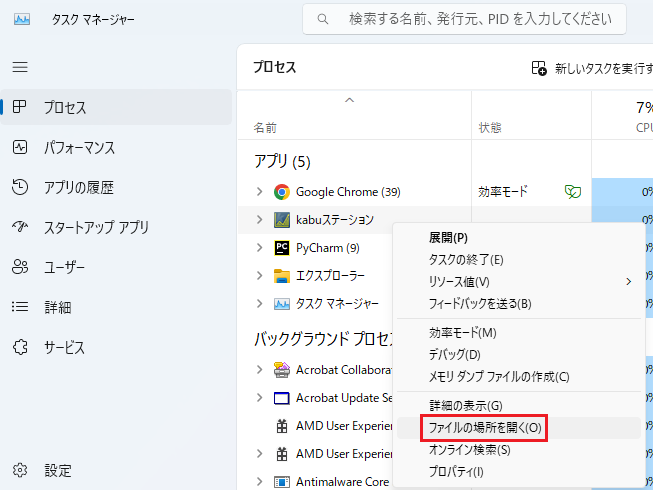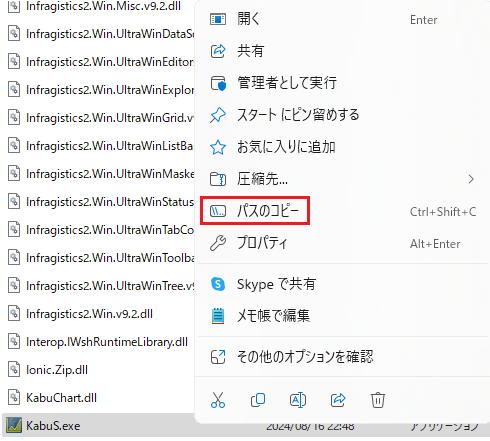この記事には広告を含む場合があります。
記事内で紹介する商品を購入することで、当サイトに売り上げの一部が還元されることがあります。
「kabuステーション®APIの使い方を解説」の記事でも触れましたが、kabuステーション®APIを使用するにはkabuステーション®を起動しておく必要があります。また、kabuステーション®の利用可能時間は、6:30から翌早朝6:15までとなっています。kabuステーション®を起動していても朝の6:15に強制的にログアウトされるので、6:30以降に再ログインしなければいけません。
通常であれば手動でkabuステーション®を閉じて、再起動させる必要がありますが、Pythonのプログラムで解決しましょう。
Pythonでは、外部ファイルを実行できたり、マウス操作やキーボード操作などを自動化できる便利なライブラリがあります。
本記事では、kabuステーション®を自動で起動して、ログインする方法について解説します。
自動化に必要なライブラリ
まずは自動化に必要なライブラリのsubprocessとPyAutoGUIを紹介します。
subprocess
subprocessは、Pythonの標準ライブラリで、Pythonから他のプログラムやコマンドを実行するためのモジュールです。
今回は、Popenクラスを使用してkabuステーション®の起動と停止を行います。
PyAutoGUI
PyAutoGUIは、マウス操作やキーボード操作などを制御できる自動化ライブラリです。
今回は、パスワードを入力してログインするために使用します。
初めて使用する場合はインストールする必要があります。コマンドプロンプトから以下のコマンドを実行します。
pip install pyautoguiPyCharmを使用されている場合は、画面下部のPythonパッケージからでもインストールできます。

kabuステーション®を起動してから停止させるサンプルコード
まずは単純にkabuステーション®を起動して、停止させるプログラムを作成します。動作の流れは次の通りです。
- kabuステーション®を起動する。
- ログインパスワードを入力する。
- ログインする。
- 10秒待つ。
- kabuステーション®を停止する。
それではサンプルコードの紹介です。
import subprocess
import pyautogui
import time
kabu_station_path = r'C:\Users\XXXXXXXXXX\KabuS.exe'
login_password = 'YOUR_PASSWORD'
# kabuステーションを起動
def start_kabu_station():
starting_state = subprocess.Popen(kabu_station_path)
time.sleep(5)
pyautogui.typewrite(login_password)
time.sleep(1)
pyautogui.keyDown('Enter')
return starting_state
# kabuステーションを停止
def stop_kabu_station(starting_state):
starting_state.kill()
kabu_station = start_kabu_station()
time.sleep(10)
stop_kabu_station(kabu_station)
kabu_station_pathは、kabuステーション®の実行ファイルがインストールされているパスを記載してください。
パスの調べ方ですが、kabuステーション®を起動した状態でタスクマネージャーを開き、kabuステーション®を右クリックして「ファイルの場所を開く」を選択します。

開かれたフォルダのKabuS.exeを右クリックして「パスのコピー」でkabuステーション®のパスが取得できます。

kabuステーション®にログインで使用するパスワードをlogin_passwordに記載して下さい。PyAutoGUIでパスワードを入力して、ログインすることができます。
このプログラムを実行すると、kabuステーション®が起動して、停止する一連の動作ができます。
自動売買プログラムのサンプルコード
前回の記事で紹介した株の自動売買プログラムに、kabuステーション®の起動・停止機能を追加したサンプルコードを紹介します。
from datetime import datetime
import time
import urllib.request
import urllib.error
import pprint
import json
import yfinance as yf
import talib
import subprocess
import pyautogui
# 設定項目
kabu_station_path = r'C:\Users\XXXXXXXXXX\KabuS.exe'
api_password = 'YOUR_PASSWORD'
login_password = 'YOUR_PASSWORD'
symbol = '9432'
qty = 100
signal = None
# トークンを発行する関数
def generate_token():
obj = {'APIPassword': api_password}
json_data = json.dumps(obj).encode('utf8')
url = 'http://localhost:18080/kabusapi/token'
req = urllib.request.Request(url, json_data, method='POST')
req.add_header('Content-Type', 'application/json')
try:
with urllib.request.urlopen(req) as res:
content = json.loads(res.read())
token_value = content.get('Token')
except urllib.error.HTTPError as e:
print(e)
return token_value
# 残高照会する関数
def check_positions(token):
url = 'http://localhost:18080/kabusapi/positions'
params = {'product': 1} # product - 0:すべて、1:現物、2:信用、3:先物、4:OP
params['symbol'] = symbol # symbol='xxxx'
params['side'] = '2' # 1:売、2:買
params['addinfo'] = 'false' # true:追加情報を出力する、false:追加情報を出力しない ※追加情報は、「現在値」、「評価金額」、「評価損益額」、「評価損益率」を意味します
req = urllib.request.Request('{}?{}'.format(url, urllib.parse.urlencode(params)), method='GET')
req.add_header('Content-Type', 'application/json')
req.add_header('X-API-KEY', token)
try:
with urllib.request.urlopen(req) as res:
print(res.status, res.reason)
for header in res.getheaders():
print(header)
print()
content = json.loads(res.read())
pprint.pprint(content)
except urllib.error.HTTPError as e:
print(e)
content = json.loads(e.read())
pprint.pprint(content)
except Exception as e:
print(e)
if not content or content[0]['LeavesQty'] == 0.0:
check_position = False
check_positions_side = None
else:
check_position = True
if content[0]['Side'] == '2':
check_positions_side = 'BUY'
return check_position, check_positions_side
# 板情報を取得する関数
def get_price_data():
symbol_data = yf.download(symbol + '.T', period='5d', interval='30m')
return symbol_data
def get_board_information(token):
url = 'http://localhost:18080/kabusapi/board/' + symbol + '@1'
req = urllib.request.Request(url, method='GET')
req.add_header('Content-Type', 'application/json')
req.add_header('X-API-KEY', token)
try:
with urllib.request.urlopen(req) as res:
print(res.status, res.reason)
for header in res.getheaders():
print(header)
print()
content = json.loads(res.read())
pprint.pprint(content)
except urllib.error.HTTPError as e:
print(e)
content = json.loads(e.read())
pprint.pprint(content)
except Exception as e:
print(e)
return content
# シグナルを判定する関数
def entry_signal(df):
df['RSI'] = talib.RSI(df['Close'], timeperiod=14)
if df.iat[-2, 6] <= 30 < df.iat[-1, 6]:
signal = 'BUY'
print('買いのシグナルが発生しました')
elif df.iat[-2, 6] >= 70 > df.iat[-1, 6]:
signal = 'SELL'
print('売りのシグナルが発生しました')
else:
signal = None
return signal
# 買い注文を出す関数
def kabusapi_sendorder_cash(token):
obj = {'Password': login_password,
'Symbol': symbol,
'Exchange': 1,
'SecurityType': 1,
'Side': '2',
'CashMargin': 1,
'DelivType': 2,
'FundType': 'AA',
'AccountType': 2,
'Qty': qty,
'FrontOrderType': 10,
'Price': 0,
'ExpireDay': 0
}
json_data = json.dumps(obj).encode('utf-8')
url = 'http://localhost:18080/kabusapi/sendorder'
req = urllib.request.Request(url, json_data, method='POST')
req.add_header('Content-Type', 'application/json')
req.add_header('X-API-KEY', token)
try:
with urllib.request.urlopen(req) as res:
print(res.status, res.reason)
for header in res.getheaders():
print(header)
print()
content = json.loads(res.read())
pprint.pprint(content)
except urllib.error.HTTPError as e:
print(e)
content = json.loads(e.read())
pprint.pprint(content)
except Exception as e:
print(e)
# 売り注文を出す関数
def kabusapi_sendorder_cash_close(token):
obj = {'Password': login_password,
'Symbol': symbol,
'Exchange': 1,
'SecurityType': 1,
'Side': '1',
'CashMargin': 1,
'DelivType': 0,
'FundType': ' ',
'AccountType': 2,
'Qty': qty,
'FrontOrderType': 10,
'Price': 0,
'ExpireDay': 0
}
json_data = json.dumps(obj).encode('utf-8')
url = 'http://localhost:18080/kabusapi/sendorder'
req = urllib.request.Request(url, json_data, method='POST')
req.add_header('Content-Type', 'application/json')
req.add_header('X-API-KEY', token)
try:
with urllib.request.urlopen(req) as res:
print(res.status, res.reason)
for header in res.getheaders():
print(header)
print()
content = json.loads(res.read())
pprint.pprint(content)
except urllib.error.HTTPError as e:
print(e)
content = json.loads(e.read())
pprint.pprint(content)
except Exception as e:
print(e)
# kabuステーションを起動
def start_kabu_station():
starting_state = subprocess.Popen(kabu_station_path)
time.sleep(5)
pyautogui.typewrite(login_password)
time.sleep(1)
pyautogui.keyDown('Enter')
return starting_state
# kabuステーションを停止
def stop_kabu_station(starting_state):
starting_state.kill()
# メイン処理
kabu_station = start_kabu_station()
time.sleep(10)
token_value = generate_token()
position, side = check_positions(token_value)
while True:
hour = datetime.now().hour
if hour == 6:
stop_kabu_station(kabu_station)
time.sleep(3600)
kabu_station = start_kabu_station()
else:
# ポジションがある場合
if position is True and side == 'BUY':
price = get_price_data()
signal = entry_signal(price)
# シグナルが発生した時
if signal == 'SELL':
kabusapi_sendorder_cash_close(token_value)
signal = None
time.sleep(10)
position, side = check_positions(token_value)
time.sleep(1800)
else:
time.sleep(60)
# ポジションがない場合
else:
price = get_price_data()
signal = entry_signal(price)
# シグナルが発生した時
if signal == 'BUY':
kabusapi_sendorder_cash(token_value)
signal = None
time.sleep(10)
position, side = check_positions(token_value)
time.sleep(1800)
else:
time.sleep(60)
ポイントの解説
前回と比較すると、主にメイン処理を変更しています。
# メイン処理
kabu_station = start_kabu_station()
time.sleep(10)
token_value = generate_token()
position, side = check_positions(token_value)
while True:
hour = datetime.now().hour
if hour == 6:
stop_kabu_station(kabu_station)
time.sleep(3600)
kabu_station = start_kabu_station()
else:
# ポジションがある場合
if position is True and side == 'BUY':
price = get_price_data()
signal = entry_signal(price)
# シグナルが発生した時
if signal == 'SELL':
kabusapi_sendorder_cash_close(token_value)
signal = None
time.sleep(10)
position, side = check_positions(token_value)
time.sleep(1800)
else:
time.sleep(60)
# ポジションがない場合
else:
price = get_price_data()
signal = entry_signal(price)
# シグナルが発生した時
if signal == 'BUY':
kabusapi_sendorder_cash(token_value)
signal = None
time.sleep(10)
position, side = check_positions(token_value)
time.sleep(1800)
else:
time.sleep(60)プログラムが実行されると、始めにkabuステーション®が起動します。これまではkabuステーション®を手動で起動して、パスワードを手動で入力してログインしていましたが、自動化することができました。
次に、datetime.now().hourで現在の時間を取得して、6時だった場合にkabuステーション®が停止します。そして、3600秒後つまり1時間後にkabuステーション®が起動するので、この処理は1日に1回だけ実行されます。
その他の時間帯は、通常通りに自動売買のプログラムが動きます。
おわりに
以上でkabuステーション®を自動で起動して、ログインする事ができました。
subprocessとPyAutoGUIを使用することでパソコンの操作を自動化することができます。
パソコン操作の自動化は、いろいろな事に応用できるので、使いこなせるようにプログラミングのスキルを身に付けていきましょう。
信用格付は主要ネット証券No.1「AA」MUFGグループならではの信頼感
- APIによる株の全自動取り引きに対応
- 「kabuステーション®」や「カブナビ®」など、用途に合わせた各種の自社開発ツールを利用可能
- 1日100万円まで手数料無料
\無料登録はこちらから!/


